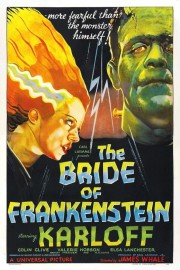Bride of Frankenstein
I wonder whether Sam Raimi thought of James Whale’s first two “Frankenstein” films when he decided to make “Evil Dead II.” That seems like a strange train of thought to follow, but when you watch “Bride of Frankenstein,” and see how the film values humor in place of terror, and then think of the lunacy of “Evil Dead II,” I think you’ll understand where I’m coming from. But “Bride of Frankenstein” isn’t some loopy comedy masquerading as a horror film, though, but rather an intelligent, logical continuation to a classic. The fact that it became a classic in it’s own right, and is still in the top tier of sequels ever made, is a credit to the artistry Whale and his collaborators brought to the film.
The story of “Bride of Frankenstein” begins where “Frankenstein” ended, with the Monster (played by Boris Karloff) seemingly killed in the burning windmill after murdering not only his own creator, but a small girl. However, the Monster isn’t quite dead, as the parents of the girl soon discover in grizzly fashion, and the Monster is terrorizing the countryside once again. His creator, Henry Frankenstein (Colin Clive), isn’t quite dead, either, and he is taken to his home to be with his fiancee, Elizabeth (Valerie Hobson). The peace he finds with Elizabeth doesn’t last long, however, when he has a visitor in Dr. Pretorius (Ernest Thesiger), who has conducted his own experiments with creating life, and has a collaboration in mind to create a mate. Understandably, Henry is hesitant, but when he sees what Pretorius has created, he becomes intrigued. Will it be too late, though?
The way Whale and screenwriter William Hurlbut come into the story is by framing the tale as told by Mary Shelley (Elsa Lanchester) to her husband, Percy, and Lord Byron on a dark, stormy night. It’s a clever way to get into the story, and it helps ground the film into the tale’s literary roots, as well as introduce Lanchester into the cast, as she will later play the titular Bride in one of the most famous moments in movie history. More than that, though, I think it helps to establish an emotional framwork that justifies the story being told that will be important as it goes along. Though it looks and feels like a horror story, “Bride of Frankenstein” is really a story of loneliness and finding a place called home. The Monster is portrayed in a sympathetic light after the opening horror. It’s easier to see this portrayal because we remember that his killing of the girl in the first film was accidental rather than malicious. Throughout “Bride,” though, we get a sense that the Monster, rather than a raging animal, has a conscious, but because he cannot speak, he is unable to connect with people in that most basic of ways we all communicate, such as when he scares a young woman he’s trying to help after she falls off a cliff into a pool of water. It’s only when he’s confronted with kindness by a blind hermit that he begins to be able to communicate through speech, albeit in rudimentary phrases and single words. Because the blind man cannot see the ugliness on the outside, he nurtures the humanity within the Monster; writing it out like that, I’m reminded of Chaplin’s “City Lights,” where only the blind flower girl treats Chaplin’s Little Tramp with respect because she cannot react to his outwardly appearance. In the end, she does see him as he is on the outside, but reacts with that same kindness. The blind hermit isn’t afforded the same opportunity, sadly, because fear is the only reaction most of the world can have towards this “Monster.” The only other person who treats the Monster with some respect is Pretorius, but that is largely because he sees the Monster as a step to his own, insidious scientific endgame. Not even Henry does that, although the Monster shows some feeling toward it’s creator at the end.
What a strange, beautiful film this is. It’s not often one discusses a horror film where Chaplin feels like an influence on what we see, and I’m not sure whether Whale had the great silent clown on his mind when making “Bride of Frankenstein,” or whether he just felt pity for the creature he and Karloff brought so memorably to the screen four years earlier. All I know is that Whale’s film has a disarming humanity that shines through the morally dark subject matter and startling production design, the latter of which was influenced by German Expressionism, and would, itself, go on to influence filmmakers for generations after, regardless of if it was film noir, the Hammer horror films of the ’50s and ’60s, Mel Brooks when he made his note-perfect “Young Frankenstein” in 1974, or directors like Guillermo Del Toro and Peter Jackson nowadays. Many other people, after the release of Bill Condon’s “Gods and Monsters,” have explored the possible subtext within Whale’s striking cinematic masterwork, but I’m perfectly content just watching the film, and appreciating the creativity he brought to the surface of this fantastic horror classic because honestly, that’s all that really matters in the long run.










